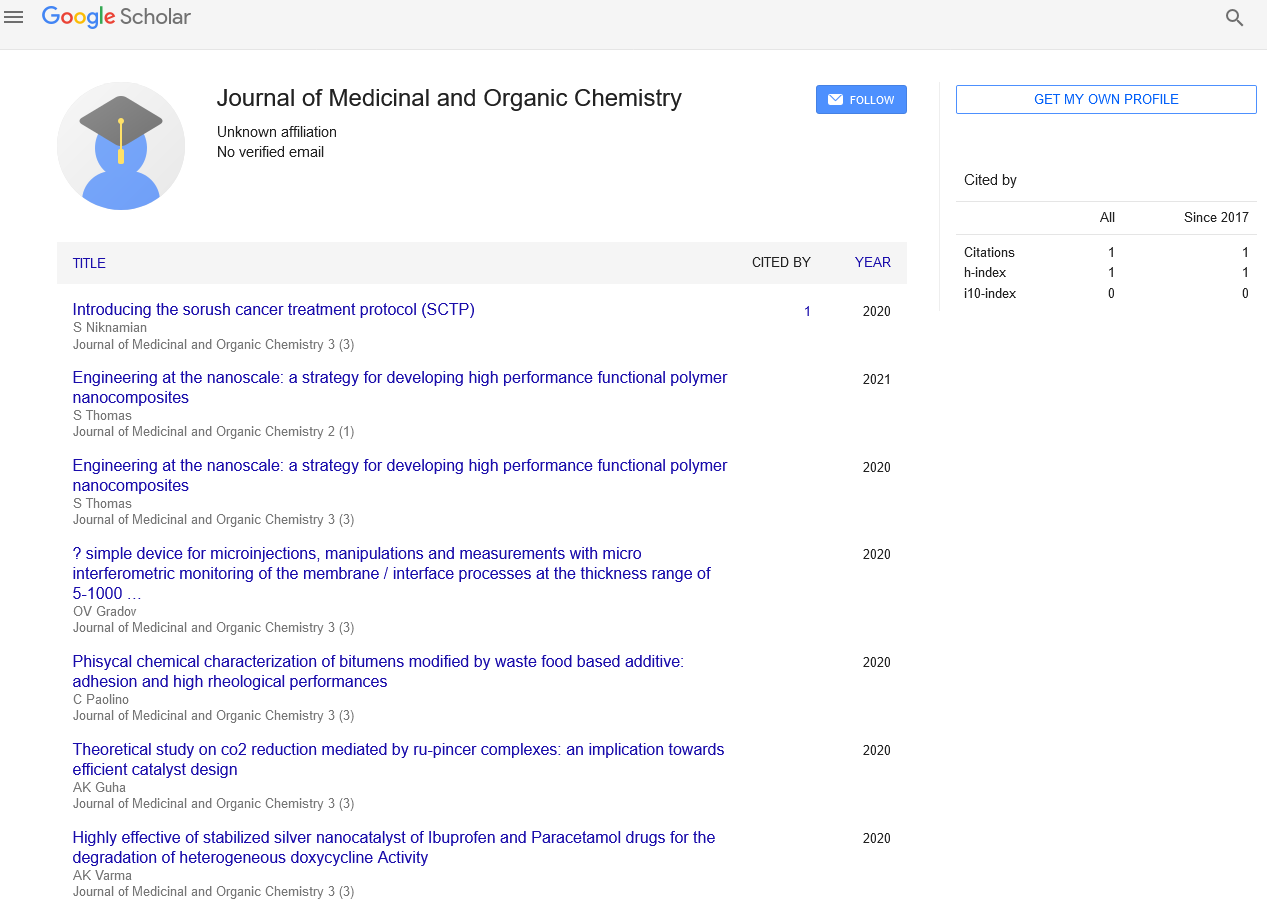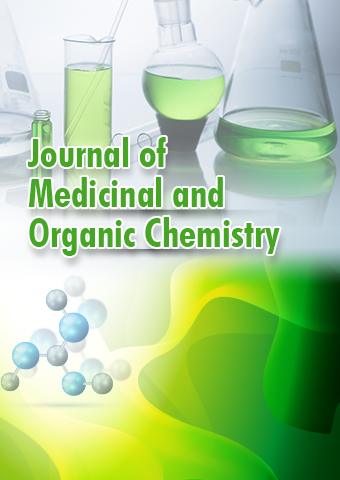Mini Review - Journal of Medicinal and Organic Chemistry (2023) Volume 6, Issue 3
Organic spectroscopy: Principles of Organic Spectroscopy
Dr. Monika Bansal*
Department of Advanced Science and Technology, University of SRG, India
Department of Advanced Science and Technology, University of SRG, India
E-mail: monika.b@gmail.com
Received: 02-June-2023, Manuscript No. jmoc-23-101946; Editor assigned: 05-June-2023, PreQC No jmoc-23- 101946; Reviewed: 19-June-2023, QC No. jmoc-23-101946; Revised: 23- June-2023, Manuscript No. jmoc-23- 101946 (R); Published: 30-June-2023; DOI: 10.37532/jmoc.2023.6(3).65-67
Abstract
Organic spectroscopy is a branch of chemistry that focuses on the study of organic compounds using various spectroscopic techniques. Spectroscopy provides valuable information about the structure, composition, and properties of organic molecules by analysing the interaction of these molecules with electromagnetic radiation. This abstract provides an overview of the fundamental principles and applications of organic spectroscopy. The abstract begins by introducing the basic concepts of spectroscopy, such as electromagnetic radiation, energy levels, and the interaction between light and matter. It then discusses the different types of spectroscopic techniques commonly employed in organic spectroscopy, including infrared spectroscopy (IR), nuclear magnetic resonance spectroscopy (NMR), ultraviolet-visible spectroscopy (UV-Vis), and mass spectrometry (MS). Infrared spectroscopy involves the study of the vibrational modes of organic molecules, providing information about functional groups and molecular structure. NMR spectroscopy, on the other hand, investigates the magnetic properties of atomic nuclei in a molecule, offering insights into the connectivity and environment of atoms within the molecule. UV-Vis spectroscopy measures the absorption and transmission of light by molecules, enabling the determination of electronic transitions and the identification of chromophores. Mass spectrometry characterizes the mass and fragmentation patterns of molecules, aiding in the identification and quantification of organic compounds.
Keywords
Spectroscopy • Organic compounds • Absorption spectra • Infrared (IR) spectroscopy • Nuclear magnetic resonance (NMR) spectroscopy • UV-Visible spectroscopy • Mass spectrometry
Introduction
Organic spectroscopy is a powerful branch of chemistry that deals with the study of the interaction between matter and electromagnetic radiation. It plays a crucial role in the identification and characterization of organic compounds. By utilizing various spectroscopic techniques, chemists can obtain valuable information about the structure, composition, and properties of organic molecules [1].
The advancement of spectroscopic techniques over the years has revolutionized the field of organic chemistry. Spectroscopy enables chemists to elucidate the connectivity of atoms, determine the functional groups present in a compound, analyze the molecular geometry, and investigate the electronic and vibrational states of organic molecules. Organic spectroscopy is widely used in a range of scientific disciplines, including medicinal chemistry, environmental analysis, forensic science, and materials science [2]. Rganic spectroscopy is a branch of analytical chemistry that focuses on the study of the interaction between matter and electromagnetic radiation in the organic compounds. It is a powerful tool used by chemists to identify and characterize organic compounds, determine their structure, and investigate their chemical properties. Spectroscopic techniques provide valuable information about the molecular structure, bonding, and functional groups present in organic compounds, aiding in the elucidation of complex organic molecules [3].
The fundamental principle underlying organic spectroscopy is that different compounds absorb and emit electromagnetic radiation at specific wavelengths, which are characteristic of their molecular structure and chemical environment. By analyzing the interactions between organic compounds and various regions of the electromagnetic spectrum, chemists can obtain detailed information about the composition and structure of these compounds [4]. There are several types of spectroscopic techniques commonly used in organic chemistry, each based on different principles and utilizing different regions of the electromagnetic spectrum. Some of the most widely employed techniques include infrared spectroscopy (IR), nuclear magnetic resonance spectroscopy (NMR), ultravioletvisible spectroscopy (UV-Vis), and mass spectrometry (MS). Each of these techniques provides unique information about different aspects of the organic compounds, allowing chemists to piece together a comprehensive picture of the molecule under investigation. Organic spectroscopy is a vital tool in the field of organic chemistry, enabling scientists to gain insights into the molecular structure and properties of organic compounds. By utilizing various spectroscopic techniques, chemists can identify unknown substances, determine their structure, and unravel the intricate details of organic molecules [5]. The continued development and application of spectroscopic methods contribute significantly to our understanding of organic compounds and their diverse roles in various scientific disciplines.
Principles of Organic Spectroscopy
Organic spectroscopy relies on the principles of energy absorption, emission, or scattering by molecules. When a molecule interacts with electromagnetic radiation, it undergoes transitions between different energy states, resulting in the absorption or emission of photons. The energy transitions occur due to changes in electronic, vibrational, or rotational states of the molecule [6].
The three main types of spectroscopy commonly used in organic chemistry are UVVisible spectroscopy, infrared spectroscopy (IR), and nuclear magnetic resonance (NMR) spectroscopy. Each technique provides unique information about different aspects of organic molecules.
UV-visible spectroscopy: UV-Visible spectroscopy involves the study of the absorption of ultraviolet and visible light by organic compounds. The technique measures the amount of light absorbed by a sample as a function of wavelength. It provides information about the electronic structure of molecules and is particularly useful in determining the presence of conjugated systems, aromatic compounds, and chromophores [7]. UV-Visible spectroscopy is widely used in the analysis of organic compounds in solution and is employed in fields such as pharmaceuticals, environmental monitoring, and materials science. It helps in the quantification of compounds, monitoring reactions, and studying the kinetics of photochemical processes.
Infrared spectroscopy (IR): Infrared spectroscopy involves the study of the absorption, reflection, or transmission of infrared radiation by organic molecules. The technique provides valuable information about the functional groups present in a compound [8]. Each functional group has a characteristic absorption pattern in the infrared region, allowing chemists to identify and characterize compounds based on their IR spectra.
IR spectroscopy is highly effective in determining the presence of various functional groups such as alcohols, carbonyl compounds, amines, and acids [9]. It is extensively used in the analysis of organic compounds, including drug discovery, forensic analysis, and quality control in industries.
Nuclear magnetic resonance spectroscopy (NMR): NMR spectroscopy is a powerful technique used for the structural elucidation of organic molecules. It exploits the magnetic properties of certain atomic nuclei, such as hydrogen (1H) and carbon (13C), to provide detailed information about the connectivity and environment of atoms in a molecule.
In NMR spectroscopy, a sample is subjected to a strong magnetic field, which causes the nuclei to align with or against the field. By applying radiofrequency pulses, the nuclei are excited and subsequently emit or absorb energy. The resulting NMR spectrum provides information about the chemical shifts, coupling constants, and integrals, which are used to determine the molecular structure [10].
NMR spectroscopy is widely used in organic chemistry to determine the connectivity of atoms, confirm the structure of organic compounds, analyze reaction mechanisms, and study molecular dynamics. It has applications in fields such as drug development, natural product isolation, and metabolomics.
Apart from UV-Visible, IR, and NMR spectroscopy, there are several other spectroscopic techniques employed in organic chemistry.
Conclusion
Organic spectroscopy is an invaluable tool in the field of organic chemistry, enabling scientists to gain insights into the structure, composition, and properties of organic compounds. Spectroscopic techniques such as infrared spectroscopy (IR), nuclear magnetic resonance (NMR) spectroscopy, ultraviolet-visible (UV-Vis) spectroscopy, and mass spectrometry (MS) provide a wealth of information that aids in the identification, characterization, and elucidation of organic molecules.
IR spectroscopy allows researchers to probe the vibrational modes of organic compounds, providing fingerprints that can be used to identify functional groups and determine molecular structure. NMR spectroscopy, on the other hand, allows for the analysis of the nuclear spins of atoms within a molecule, offering information about connectivity, stereochemistry, and dynamic behavior.
UV-Vis spectroscopy provides valuable data on the electronic transitions within molecules, helping to determine their electronic structure, conjugation, and absorbance properties. Mass spectrometry, with its ability to ionize and fragment molecules, provides precise information about molecular weight, elemental composition, and structural fragments. By combining these spectroscopic techniques and utilizing their complementary nature, researchers can obtain a comprehensive understanding of the organic compounds under investigation. The data obtained from these techniques, when interpreted and analysed correctly, can assist in the determination of chemical structures, the verification of synthetic routes, the detection of impurities, and the investigation of reaction mechanisms.
References
- Leggat PA. Occupational hygiene practices of dentists in southern Thailand. International Dental Journal. 51, 11-16(2001).
- Gelbier, Stanley. Dentistry and the University of London. Medical History. 49, 445-462(2005).
- Capper S. Book Review: Silent Victories: The History and Practice of Public Health in Twentieth-Century America. Inquiry. 44, 128-129(2007).
- Le P, Dempster L, Limeback H et al. Improving residents' oral health through staff education in nursing homes. Special Care in Dentistry. 32, 242-50(2012).
- Shimazu T, Kuriyama S, Hozawa A et al. Dietary patterns and cardiovascular disease mortality in Japan: a prospective cohort study. Int J Epidemiol. 36, 600-609 (2007).
- Chockalingam A, Campbell NR, Fodor JG. Worldwide epidemic of hypertension. Canadian Journal of Cardiology. 22,553-555 (2006).
- De Stefani E, Rocco A.L, Deneo-Pellegrini H. et al. Dietary patterns and risk of adenocarcinoma of the lung in males: a factor analysis in Uruguay. Nutr Cancer.63,699-706 (2011).
- Kant A.K. Dietary patterns and health outcomes. J Am Diet Assoc.104,615-635 (2004).
- Esfahani A, Wong J MW, Truan J et al. Health effects of mixed fruit and vegetable concentrates: a systematic review of the clinical interventions. J Am Coll Nutr.30,285-294(2011).
- Heidemann C, Scheidt-Nave C, Richter A et al. Dietary patterns are associated with cardiometabolic risk factors in a representative study population of German adults. British Journal of Nutrition. 106,1253-1262 (2011).
Indexed at, Google Scholar, Crossref
Indexed at, Google Scholar, Crossref
Indexed at, Google Scholar, Crossref
Indexed at, Google Scholar, Crossref
Indexed at, Google Scholar, Crossref
Indexed at, Google Scholar, Crossref
Indexed at, Google Scholar, Crossref
Indexed at, Google Scholar, Crossref

